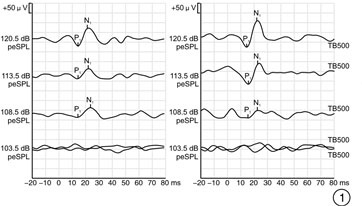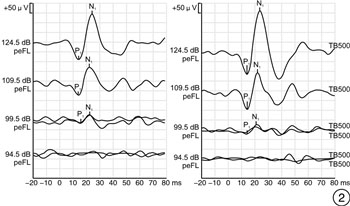Characteristics of air-conducted and bone-conducted vibration cervical vestibular-evoked myogenic potential in preschool children
-
摘要: 目的 记录学龄前正常儿童气导声刺激和骨导振动刺激诱发的颈肌前庭诱发肌源性电位(cVEMP)引出情况和各项参数指标,为我国学龄前儿童cVEMP检测提供正常参考。方法 选取44例(88耳)3~7岁正常健康儿童,按照年龄分为3~4岁组(17例34耳)和5~7岁组(27例54耳),分别行气导声刺激诱发的cVEMP(ACS-cVEMP)和骨导振动刺激诱发的cVEMP(BCV-cVEMP)检测,记录引出率及波形参数,并采用SPSS 18.0统计软件进行统计学分析。结果 44例(88耳)正常儿童ACS-cVEMP和BCV-cVEMP引出率分别为96.59%(85/88)和97.73%(86/88),差异无统计学意义(P>0.05)。3~4岁组与5~7岁组的ACS-cVEMP引出率分别为94.12%(32/34)和98.15%(53/54),差异无统计学意义(P>0.05);3~4岁组与5~7岁组BCV-cVEMP引出率分别为94.12%(32/34)和100.00%(54/54),差异无统计学意义(P>0.05)。与5~7岁组相比,3~4岁组ACS-cVEMP的p1、n1潜伏期较短(P < 0.05),振幅较高(P < 0.05),其余参数均差异无统计学意义(P>0.05)。两个年龄组间BCV-cVEMP的引出率、p1潜伏期、n1潜伏期等各参数间的差异均无统计学意义(P>0.05)。结论 大部分学龄前儿童可引出ACS-cVEMP和BCV-cVEMP,cVEMP是一种可行的儿童前庭功能检测手段。
-
关键词:
- 儿童 /
- 颈肌前庭诱发肌源性电位 /
- 气导声刺激 /
- 骨导振动刺激
Abstract: Objective To investigate the characteristics of air-conducted sound cervical vestibular evoked myogenic potential (ACS-cVEMP) and bone-conducted vibration cervical vestibular evoked myogenic potential (BCV-cVEMP) in healthy preschool children, and to provide the normal reference range of VEMP for preschool children in China.Methods Forty-four normal-hearing children (88 ears) aged 3-7 years were recruited to undergo ACS-cVEMP and BCV-cVEMP determination. These children were divided into two groups according to age: 3-4 years old group (17 cases, 34 ears) and 5-7 years old group (27 cases, 54 ears). The response rates and waveform parameters were recorded and analyzed statistically using SPSS 18.0 software.Results The response rates of ACS-cVEMP, BCV-cVEMP in 44 normal-hearing children (88 ears) were 96.59%(85/88) and 97.73%(86/88) respectively, and there was no significant difference between the two groups (P > 0.05). The response rates of ACS-cVEMP in 3-4 year old group and 5-7 year old group were 94.12% (32/34) and 98.15% (53/54) respectively, and there was no significant difference between the two groups(P>0.05); The response rates of BCV-cVEMP in 3-4 year old group and 5-7 year old group were 94.12% (32/34) and 100.00%(54/54) respectively, and there was no significant difference between the two groups (P>0.05). Compared with the 5-7 year old group, the latency of p1 and n1 in the 3-4 year old group was shorter (P < 0.05) and the amplitude was higher (P < 0.05), and there was no significant difference in other parameters (P>0.05). There was no statistical difference in threshold, n1, p1 latency, n1-p1 wave interval, n1-p1 amplitude, and amplitude asymmetry ratio of BCV-cVEMP between the two groups (P>0.05).Conclusion ACS-cVEMP and BCV-cVEMP can be elicited in most preschool children, and cVEMP is a feasible method to detect vestibular function in children. -

-
表 1 正常儿童ACS-cVEMP各项参数
组别 耳数 引出率/% 阈值/dB peSPL p1潜伏期/ms n1潜伏期/ms p1-n1波间期/ms p1-n1振幅/μV 耳间振幅不对称比 3~4岁组 34 94.12 111.94±4.83 13.21±2.59 20.21±2.35 7.07±1.53 135.17±72.43 0.16±0.09 5~7岁组 54 98.15 110.95±5.43 14.61±1.91 22.04±2.06 7.43±1.87 104.80±54.72 0.15±0.10 P值 — 0.310 0.401 0.005 < 0.001 0.355 0.031 0.922 表 2 正常儿童BCV-cVEMP各项参数
组别 耳数 引出率/% 阈值/dB peFL p1潜伏期/ms n1潜伏期/ms p1-n1波间期/ms p1-n1振幅/μV 耳间振幅不对称比 3~4岁组 34 94.12 104.97±7.22 14.59±1.90 23.00±2.19 8.38±2.00 164.49±97.26 0.17±0.13 5~7岁组 54 100.00 106.07±5.65 14.66±1.67 23.53±2.77 8.87±2.12 166.52±86.43 0.16±0.10 P值 — 0.071 0.432 0.850 0.357 0.295 0.920 0.833 -
[1] Colebatch JG, Halmagyi GM, Skuse NF. Myogenic potentials generated by a click-evoked vestibulocollic reflex[J]. J Neurol Neurosurg Psychiatry, 1994, 57(2): 190-197. doi: 10.1136/jnnp.57.2.190
[2] Ferber-Viart C, Dubreuil C, Duclaux R. Vestibular evoked myogenic potentials in humans: a review[J]. Acta Otolaryngol, 1999, 119(1): 6-15. doi: 10.1080/00016489950181864
[3] 吴子明, 张素珍, 杨伟炎, 等. 前庭诱发的肌源性电位原理与应用[J]. 中华耳科学杂志, 2004, 2(1): 70-72, 47. https://www.cnki.com.cn/Article/CJFDTOTAL-ZHER200401025.htm
[4] 张青, 许信达, 许珉, 等. 眼肌和颈肌前庭诱发肌源性电位在外周性前庭传导通路疾病诊断中的应用[J]. 临床耳鼻咽喉头颈外科杂志, 2015, 29(2): 147-151. https://www.cnki.com.cn/Article/CJFDTOTAL-LCEH201502014.htm
[5] Papathanasiou ES, Murofushi T, Akin FW, et al. International guidelines for the clinical application of cervical vestibular evoked myogenic potentials: an expert consensus report[J]. Clin Neurophysiol, 2014, 125(4): 658-666. doi: 10.1016/j.clinph.2013.11.042
[6] Janky KL, Shepard N. Vestibular evoked myogenic potential(VEMP)testing: normative threshold response curves and effects of age[J]. J Am Acad Audiol, 2009, 20(8): 514-522. doi: 10.3766/jaaa.20.8.6
[7] McCaslin DL, Jacobson GP, Hatton K, et al. The effects of amplitude normalization and EMG targets on cVEMP interaural amplitude asymmetry[J]. Ear Hear, 2013, 34(4): 482-490. doi: 10.1097/AUD.0b013e31827ad792
[8] 张玉忠, 魏馨雨, 陈耔辰, 等. 骨导振动刺激诱发的前庭诱发肌源性电位[J]. 中国耳鼻咽喉颅底外科杂志, 2018, 24(6): 513-517. https://www.cnki.com.cn/Article/CJFDTOTAL-ZEBY201806004.htm
[9] 周灯香, 陈耔辰, 何珍, 等. 儿童前庭诱发肌源性电位检测方法及临床研究现状[J]. 临床耳鼻咽喉头颈外科杂志, 2021, 35(7): 654-658. https://www.cnki.com.cn/Article/CJFDTOTAL-LCEH202107019.htm
[10] Wang SJ, Hsieh WS, Young YH. Development of ocular vestibular-evoked myogenic potentials in small children[J]. Laryngoscope, 2013, 123(2): 512-517. doi: 10.1002/lary.23535
[11] Inoue A, Iwasaki S, Ushio M, et al. Effect of vestibular dysfunction on the development of gross motor function in children with profound hearing loss[J]. Audiol Neurootol, 2013, 18(3): 143-151. doi: 10.1159/000346344
[12] 王振华. 儿童前庭功能定量检查[J]. 听力学及言语疾病杂志, 2020, 28(2): 229-235. doi: 10.3969/j.issn.1006-7299.2020.02.028
[13] Chen CN, Wang SJ, Wang CT, et al. Vestibular evoked myogenic potentials in newborns[J]. Audiol Neurootol, 2007, 12(1): 59-63. doi: 10.1159/000097248
[14] 苏怡, 张革化, 曾祥丽. 前庭诱发肌源性电位的影响因素[J]. 国际耳鼻咽喉头颈外科杂志, 2009, 33(3): 135-137. https://www.cnki.com.cn/Article/CJFDTOTAL-SDYU202005002.htm
[15] 张琦, 冷辉, 石磊, 等. 改良检查体位对正常青年人颈性前庭诱发肌源性电位的影响[J]. 临床耳鼻咽喉头颈外科杂志, 2019, 33(2): 101-102, 105. https://www.cnki.com.cn/Article/CJFDTOTAL-LCEH201902002.htm
[16] Wang SJ, Yeh TH, Chang CH, et al. Consistent latencies of vestibular evoked myogenic potentials[J]. Ear Hear, 2008, 29(6): 923-929. doi: 10.1097/AUD.0b013e3181853019
[17] 韩朝, 田亮, 王璟, 等. 颈性前庭诱发肌源性电位正常值及影响因素的探讨[J]. 中国眼耳鼻喉科杂志, 2015, 15(2): 101-104. https://www.cnki.com.cn/Article/CJFDTOTAL-YRBH201502008.htm
[18] 沈佳丽, 孙夏雨, 陈向平, 等. 听力正常儿童骨导前庭诱发肌源性电位正常值的建立[J]. 山东大学耳鼻喉眼学报, 2020, 34(5): 72-77. https://www.cnki.com.cn/Article/CJFDTOTAL-SDYU202005013.htm
[19] 张青, 许信达, 牛晓蓉, 等. 年龄因素对气导声刺激诱发的眼肌和颈肌前庭诱发肌源性电位的影响[J]. 中华耳鼻咽喉头颈外科杂志, 2014, 49(11): 897-901.
[20] Sheykholeslami K, Megerian CA, Arnold JE, et al. Vestibular-evoked myogenic potentials in infancy and early childhood[J]. Laryngoscope, 2005, 115(8): 1440-1444.
-





 下载:
下载:
